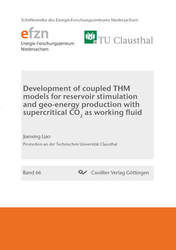| Departments | |
|---|---|
| Book Series (96) |
1378
|
| Nachhaltigkeit |
3
|
| Gesundheitswesen |
1
|
| Humanities |
2364
|
| Natural Sciences |
5406
|
| Engineering |
1793
|
| Engineering | 292 |
| Mechanical and process engineering | 862 |
| Electrical engineering | 686 |
| Mining and metallurgy | 30 |
| Architecture and civil engineering | 75 |
| Common |
98
|
|
Leitlinien Unfallchirurgie
5. Auflage bestellen |
|
Advanced Search
Development of coupled THM models for reservoir stimulation and geo-energy production with supercritical CO2 as working fluid (Volume 66) (English shop)
Jianxing Liao (Author)Preview
Extract, PDF (1.7 MB)
Table of Contents, PDF (130 KB)
In this dissertation, two specific numerical models have been developed to address the issues associated with utilization of supercritical CO2, like fracture creation, proppant placement and fracture closure in unconventional gas reservoirs, reservoir stimulation, heat production and CO2 sequestration in deep geothermal reservoirs, respectively. In unconventional gas reservoir, the model consisting of classic fracture model, proppant transport model as well as temperature-sensitive fracturing fluids (CO2, thickened CO2 and guar gum) has been integrated into the popular THM coupled framework (TOUGH2MP-FLAC3D), which has the ability to simulate single fracture propagation driven by different fracturing fluids in non-isothermal condition. To characterize the fracture network propagation and internal multi fluids behavior in deep geothermal reservoirs, an anisotropic permeability model on the foundation of the continuum anisotropic damage model has been developed and integrated into the popular THM coupled framework (TOUGH2MP-FLAC3D) as well. This model has the potential to simulate the reservoir stimulation and heat extraction based on a CO2-EGS concept.
| ISBN-13 (Hard Copy) | 9783736972421 |
| ISBN-13 (eBook) | 9783736962422 |
| Final Book Format | A5 |
| Language | English |
| Page Number | 180 |
| Edition | 1 |
| Book Series | Schriftenreihe des Energie-Forschungszentrums Niedersachsen (EFZN) |
| Volume | 66 |
| Publication Place | Göttingen |
| Place of Dissertation | Clausthal |
| Publication Date | 2020-07-28 |
| General Categorization | Dissertation |
| Departments |
Technical mechanics
|
| Keywords | Numerical model, Supercritical CO2 , THM coupling, Tight gas reservoir, CO2-EGS, Reservoir stimulation, Heat production, CO2 sequestration, Gas-based fracturing , Multi-Phase, Porous flow, Fracture flow, Geoenergie, Proppantplatzierung, Frakturerzeugung, Gaslagerstätten, Lagerstättenstimulierung, geothermische Reservoirs, Fracturing-Fähigkeit, Proppant-Tragfähigkeit, Guarkernmehl, Unterdruck, Viskosität, Leckrate, Expansionseffekt, Ausdehnungseffekt, Schadensdurchlässigkeitsmodell, Permeabilität, Prioritätskanal, Endtemperatur, fracture generation, proppant placement, gas deposits, reservoir Stimulation, Vacuum, leakage rate, expansion effect, final temperature, time discretization, Zeitdiskretisierung, thermal dynamic properties, Modellverifizierung, Gasvorkommen, Injektionsloch, Produktionsbohrung, Segmente, segments, model verification, Speichergestein, Wasserknappheit, Wirtsgesteinstyp, Vulkangestein, volcanic stone |








